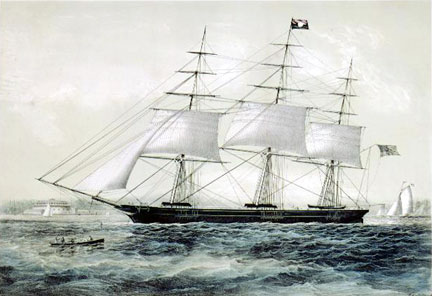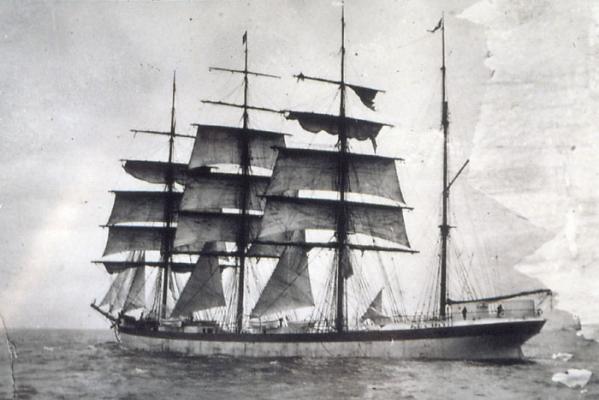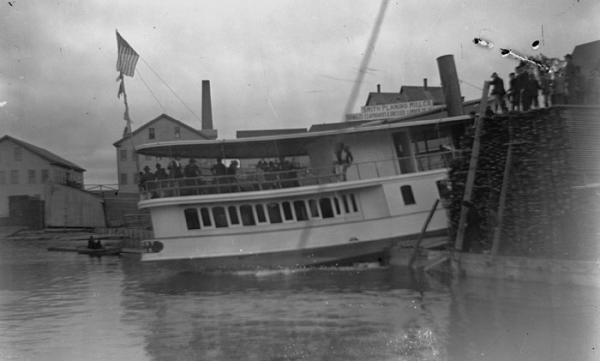-
Posts
3,156 -
Joined
-
Last visited
Content Type
Profiles
Forums
Gallery
Events
Everything posted by trippwj
-
That would be correct based on information I have come across in a couple of books (I can try and find the references tonight if interested). Apparently they provided, while not having the same level of the ease as the ratlines, at least a method of getting aloft without the use of a bosuns seat.
-
The foresail would be lowered to the deck level and furled there. The Main topmast staysail would be lowered to the foremast using the downhaul. Crew would use the mast rings to access the topmast. On the gaff topsail, a similar process - would be brought to the main mast using the downhaul, then lowered to the level of the cap. Access again via the mast rings.
-

"Follow the topic"
trippwj replied to Nirvana's topic in Using the MSW forum - **NO MODELING CONTENT IN THIS SUB-FORUM**
Dang, Pete - I sold my old 300 baud modem last week.... -

Red Right Returning, history question
trippwj replied to Modeler12's topic in Nautical/Naval History
For an interesting analysis of the international background (note that the major impetus was between the world wars and then subsequent to WW2), see the attached document from the International Association of Lighthouse Authorities. A plethora of information is also available on the Tideland Signal website at http://www.tidelandsignal.com/web/html/IALA-CD.htm MBS1.pdf -

Red Right Returning, history question
trippwj replied to Modeler12's topic in Nautical/Naval History
Thanks, Augie. Back in my youth, we would go fishing out of Mattapoisett - best fishing for Tautog was usually at Nun 8, and the best area for blues was around Can 3. -

Red Right Returning, history question
trippwj replied to Modeler12's topic in Nautical/Naval History
The US Coast Guard has an interesting summary of the evolution of channel buoy in the US. Some excerpts here (full story is at http://www.uscg.mil/history/weblighthouses/h_buoys.asp ). Early buoyage descriptions are far from complete. The Collectors of Customs contracted with local pilots and other concerns for the establishment and maintenance of minor aids on an annual basis. Spar buoys, made of long cedar or juniper poles, and cask buoys were the predominant buoys in U.S. coastal waters until the 1840s. The United States did not have a standard system of buoyage until 1848. Colors, shapes and sizes varied from port to port. This lack of regulation gave individual contractors free reign to decide the types of buoys necessary for a given area or harbor. By 1846, Secretary of the Treasury Robert L. Walker knew the time for change had come. He admitted that buoys placed by local authorities under loose regulations, coupled with the lack of standardized colors and numbers, were practically useless. Congress, sensitive to complaints about the ATON (Aids To Navigation) system, began taking steps to correct the problems in 1848. It adopted the Lateral System for implementation nationwide. It is from the Lateral System that the familiar "right, red, return" has its origin. Armed with its mandate to correct and improve aids, the newly-established Lighthouse Board stumbled into action. The board made every effort to learn from the advances of lighthouse construction and buoyage in Europe, which was far ahead of the United States. The governments of Great Britain and France placed considerable emphasis on the maintenance of safe sea roads. Under the stricter eye of the Lighthouse Board, buoyage in the United States steadily improved. Spars and cask buoys gave way to can- and nun-shaped riveted iron buoys. These buoys were set according to the Lateral System: red nuns to the starboard of channels as observed by ships returning to port, and black can buoys to the port. The board also standardized sizes to maximize visibility. This system continues in use even today, except that can buoys are now painted green. Tests in the 1970s showed that green is more highly visible from a greater distance. The board began purchasing buoys through inspectors and superintendents in individual districts. It would be interesting to see what the practice was in the mid 19th century in Europe, particularly Britain and France where the Lighthouse Board looked for "best practices". -
Sorry Sarah - not the Red Jacket (and they are difficult to tell apart!). Spyglass - you are correct - it is indeed the Nightingale. She carried Jenny Lind as her figure head, and there are some interesting tales concerning the figurehead still today! Your turn, Spyglass!
-
No, not the Snow squall. Yes, a transplant from Maine or, as they refer to us here in Arkansas, a Damn Yankee (that's one who came here and stayed).
-
Hmmmm....this vessel was variously described as one of the most beautiful nd most interesting ships of the clipper era....and did I mention she was built in Maine?
-

"Follow the topic"
trippwj replied to Nirvana's topic in Using the MSW forum - **NO MODELING CONTENT IN THIS SUB-FORUM**
If you want to automatically follow topics you have posted in, click on your username at the top left of the screen, then click My Settings. On the next screen you will see Notification Options on the left. Click that. On that screen you will see Topics & Posts with a check box next to Auto follow topics I reply to. Check that box, and select the notification frequency in the drop down box. Scroll to the bottom and click Save Changes and that, theoretically, will automatically get you notifications for any topic you reply to. Good Luck! -
Thank you, Pav - I think our posts crossed paths on the internet! Here is the next vessel to consider:
-
Would it be the Monkbarns?
-
Let's see what maaaslo has to say first - there is one other possibility as well.
-

Question about mast angle/length on phantom build
trippwj replied to kdnash's topic in Masting, rigging and sails
You'll need to measure the length above deck from the Rigging Plan (and add the 1/2" that goes below deck). I come up with 8 1/4" from deck to top of mast cap. -
German sailing ship raider See-Adler?
-
Well done, Pav. It is, indeed, the Dirigo. Built in Maine using British plans, steel and labor. Your turn!
-
-
The Brazilian Battleship Aquidabã (Aquidaban), renamed after the rebellion in 1894 to Dezesseis de Abril (16th of April) and then to Vinte e Quatro de Maio (24th of May) before being renamed to her original name in 1900.
-
Dang - that was an easy one I guess! I figured an obscure old steamer built where my better half was born and raised would take a tad longer than that! Yep - Steamer Tremont being lanuched in Brewer, Maine in 1895 for the Bangor and Bar Harbor Steam Boat Company. Thanks for the good wishes, Anja - and now you get to post the next one!
-

Cruizer-class Brig-Sloops of the Royal Navy
trippwj replied to molasses's topic in Nautical/Naval History
This is a most interesting thread! Frolick - would be interested in learning more about your book if you would care to share (possibly in the Books section so we con'd hijack this thread completely!) -
Commander Sjors, Your ships are both looking amazing - you have a great talent and I am learning from your builds. I have a long way to go to reach your level of craftmanship!
-
-
Kevin - Because of the length of the bowsprit and jbboom on many clippers, the jibboom was rigged to be retracted at wharf side to avoid entanglement r damage from wagons and carts passing by.
About us
Modelshipworld - Advancing Ship Modeling through Research
SSL Secured
Your security is important for us so this Website is SSL-Secured
NRG Mailing Address
Nautical Research Guild
237 South Lincoln Street
Westmont IL, 60559-1917
Model Ship World ® and the MSW logo are Registered Trademarks, and belong to the Nautical Research Guild (United States Patent and Trademark Office: No. 6,929,264 & No. 6,929,274, registered Dec. 20, 2022)
Helpful Links
About the NRG
If you enjoy building ship models that are historically accurate as well as beautiful, then The Nautical Research Guild (NRG) is just right for you.
The Guild is a non-profit educational organization whose mission is to “Advance Ship Modeling Through Research”. We provide support to our members in their efforts to raise the quality of their model ships.
The Nautical Research Guild has published our world-renowned quarterly magazine, The Nautical Research Journal, since 1955. The pages of the Journal are full of articles by accomplished ship modelers who show you how they create those exquisite details on their models, and by maritime historians who show you the correct details to build. The Journal is available in both print and digital editions. Go to the NRG web site (www.thenrg.org) to download a complimentary digital copy of the Journal. The NRG also publishes plan sets, books and compilations of back issues of the Journal and the former Ships in Scale and Model Ship Builder magazines.





